

Eudicots

Magnolias

Search
Clovegarden
SAFARI
Users
|
|
|
Sandlewood Family
- [Santalaceae]
For the famous incense sandlewood (Santalum album) I have
no mention of food value, but several closely related species do. All
sandlewoods are hemiparisites, producing sugars by photosynthesis but
stealing water and nitrogen from host plants, most often acacia species.
For cultivation both the sandlewood and the host have to be planted
and maintained together.
|
Desert Quandong -
[Native Peach; Santalum acuminatum]
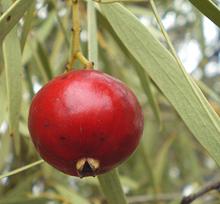
This small tree, or more commonly shrub, is found in scattered
populations in all of southern mainland Australia, from the center
of the country on south. The red or sometimes yellow fruit is
spherical and about 1-1/2 inches diamter with tart flesh described
as tasting like peach, apricot or rhubarb. The flesh is thin, only a
little more than 1/10th inch thick, covering a hard nut shell with a
convoluted brain-like surface. Within the shell is a nut so high in
oil it will burn like a candlenut.
Both the fruit flesh and the nut are edible, and both were used by
the native people of Australia, though more commonly the nut. Fruit
was harvested from the tree and could be dried, but nuts could be
more easily gathered from emu droppings, passing through the birds
with no damage. The fruit of this tree is now being exploited
commercially, with most of it exported from Australia into the
exotic food market (if it's rare and expensive it must be a
"superfood" right?). Pilot projects to farm this tree are under
way.
Photo by John Moss contributed to the Public Domain
.
Desert Mistletoe -
[Mesquite Mistletoe; Phoradendron californicum]
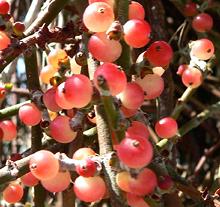
This mistletoe is native to California, Nevada and Arizona in the U.S.
and Sonora, Sinaloa and Baja California in Mexico. Desert Mistletoe,
like all Mistletoes, is a shrub that roots to branches of trees. Like
others, it is a hemiparisite, having enough chlorophyll to produce
much of its own energy, but sucking water, minerals and other
nutrients from the host tree. Like other mistletoes, the plant is
very toxic, but unlike the others, the fruits are edible - if the
plant is growing on mesquite, ironwood or catclaw acacia.
American Indians gathered the berries when they became translucent,
between November and April. Some ate them raw, others mashed them and
cooked them to a paste or pudding consistency. The foliage is reputed
to be halucinogenic, but the dosage is impossible to judge, so persons
trying it are as likely to end up dead as tripping.
Photo by Stan Shebs distributed under license Creative
Commons
Attribution ShareAlike 3.0 Unported, Attribution Required.
Cape Sumach -
[Pruimbos (Plum Bush in Afrikaans); Osyris compressa]
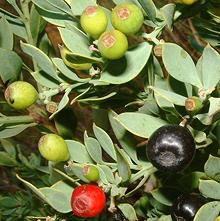
Native to South Africa, this shrub or small tree is rated as
"facultatively hemiparasitic", which means it prefers to suck some
of its nutrients from other plants, but it can actually survive
on its own if need be. The fruits, up to nearly 1 inch long and
over 1/2 inch diameter are edible. they have been used by the
Khoikhoi people both fresh and as dried pulp. The taste has been
described as "plumlike", but also as "sour and tingly". An extract
boiled from the bark has been used to flavor tea.
Photo by Abu Shawka contributed to the Public Domain
.
Native Cherry -
[Broad Leaved Ballart, Scrub Sandal-wood, Scrub Cherry,
Oringorin, Broad Leaved Cherry; Exocarpos latifolius
| Native Cherry, Cherry Ballart; Exocarpos cupressiformis]
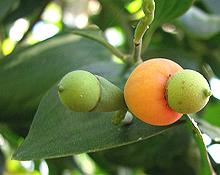
Native to Northern Australia, Indonesia and New Guinea, these shrubs
or small trees are rated as a hemiparasite, sucking some of their
nutrients and water from nearby plants. The Fruit is a bit strange.
The real fruit is a nut at the end of a stem, but during the ripening
the stem swells to almost 1/4 inch diamtere and takes color, orange
or red. The nut itself is not edible, but the swolen stem is. It is
ripe when about to fall off the tree, and may be eaten raw or cooked.
Photo of E. latifolius fruit by Melburnian
distributed under license Creative Commons
Attribution ShareAlike 3.0 Unported.
|
Sourplum Family
- [Olacaceae]
Some trees in this family can be hemi-parasites, getting some of
their nutrients and water from the roots of nearby plants, but they
are not as dependent on paracitism as the related sandlewood family.
|
Large Sourplum -
[Suurpruim, Mtundakula, Mpingi, UmThunduluka-obomvu,
Amatu nduluka; Ximenia caffra]
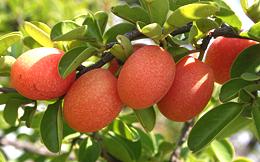
These spiny shrubs, growing to 20 feet, are native to Sub-Saharan
Africa. They produce fruits about 1.4 inches long and an inch in
diameter, which range from orange to red when ripe. The juicy flesh
is the same color. They contain a hard nut containing a seed that is
valuable for oil, though not cooking oil. The fruit is sour,
but edible raw, and best when just a bit over-ripe. It is also used
to make jams for storage, and used in deserts.
Photo of by Paul Venter distributed under license
Creative Commons
Attribution ShareAlike 3.0 Unported.
Tallow Plum -
[Sea Lemon, Tallow Wood, Yellow Plum, Blue Sourplum;
Iholotshane, Mutengeninyatwa, Mutsanzavabere, Umswanja (Africa);
Ximenia americana]

This sprawling shrub or small tree is native to tropical woodlands in
Florida and the Caribbean, Asia and Africa. It can be parasitic on
the roots of nearby trees. The yellow or orange fruits, about 1 inch
long, can be quite sour, a bit bitter with an almond flavor (cyanide),
or pleasant and plum-like in flavor. They can be eaten raw of made
into jams and jellies or used in refreshing beverages. In Asia, young
leaves are cooked as a vegetable, but need to be cooked well to drive
off the cyanide they contain. Oil from the single seed kernel can be
used for cooking. The plant is also used medicinallly, particularly
for constipation.
Photo of by J.M.Garg distributed under license Creative
Commons
Attribution ShareAlike 3.0 Unported.
Gabon Nut -
[African Walnut, Congowood, Tigerwood;
Ximenia americana]
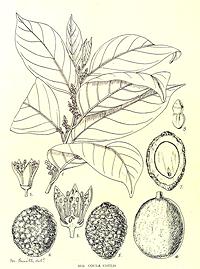
This fairly large tree (to 120 feet) is native to western Africa from
Sierra Leone south to Angola and East into Zimbabwe (DR Congo). The
fruit is about 1-1/2 inches long with red or green flesh about 0.15
inch thick. The nuts have a very hard shell and a kernal that is
50% fat, mostly Oleic Acid (monounsaturated). I have seen no mention
that the flesh is edible, but the nut kernels are said to have a taste
between hazlenuts and chestnuts. They can be eaten raw, roasted or
boiled before consumption and are often used mixed with meats in
recipes. The oil can be used for cooking.
Drawing (1906) in Public Domain, U.S. copyright expired
.
|
|
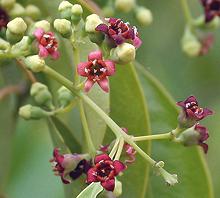 Sandlewood Order
Sandlewood Order Sandlewood Order
Sandlewood Order